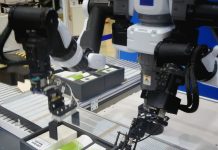So, 2020 huh? After a pandemic, a recession, an impeachment and a number of devastating wildfires, it’s difficult to believe that we’re only eight months into the year. Whilst knowing what else might happen before the end of the year is hard, one prediction is easy – it’s going to be all about the software. Software development has seen a stratospheric rise in recent years and, this has been accelerated further by the COVID-19 pandemic. As people closed themselves off from the outside world, they began to rely even more heavily on technology in general and, apps and software in particular. In this article, we’re going to take a look at some of the top software trends in 2020 and, what we can expect from 2021.
2020 – The Story So Far
Real software, artificial intelligence
OK, so we know that AI isn’t brand new, however, it still deserves top billing for 2020 as there continue to be some significant advances. At the moment, it seems that AI and machine learning have no limits – in fact, studies show that the AI market is set to rise to USD $118.6 billion by 2025; a year that’s so close we can almost touch it. In 2020, AI has been an integral part of data collection, software testing and consumer support programs as well as hugely important advances in the medical field; not least in the work toward beating COVID-19. A major issue in 2020 has been in trying to cut down on or eliminate hand to hand and hand to surface contact. This has meant that AI’s automation capabilities have really been brought to the fore and have had a hand in improving safety for restaurants, bars, banks and much much more. While nobody’s saying that human employees are about to be replaced en mass, this year has very much highlighted the benefits of bots, automation and all the other good stuff that artificial intelligence brings to the table.
The Internet of Things – ALL Things
The term Internet of Things (ioT) first came into being in 1999 and is used to describe the connection between the internet and the physical world. Although the original term is almost obsolete now in a world where the internet dominates our lives, the meaning is more important than ever – connecting our online and offline lives and building networks to make things faster, smarter and more reactive. “In 2020, we use software technology under the ioT umbrella to do everything from adding a vital extra layer of security for ecommerce sites to turning our home heating on from the office via our mobile phones” says Jack Zmudzinski, a senior associate at startnearshoring. With so much rapid progression and advancement, we can expect to be hearing this term throughout the back end of 2020 and beyond – waaaaaay beyond.
The proof is in the sourcing
For the last few years, we’ve known that, when it comes to software development, the smart money is on outsourcing. In a relatively short time, several countries within Eastern and Central Europe have become hot spots for software development outsourcing and, some of the most popular are:
- Poland
- Russia
- Ukraine
- Czech Republic
- Estonia
- Romania
Common thinking is that these destinations are chosen purely because of the low prices offered but, this is far from the case. While there are considerable cost savings to be had, all of these countries also offer a wealth of fresh talent and innovation through highly acclaimed agencies such as Future Processing in Poland.
As 2020 moves toward its finale, the extraordinary events of this year, while devastating for many, will prove to have offered new opportunities to even more previously overlooked software development destinations.
On the edge
In 2020, we’re soooooooo over the Cloud. Well, not entirely but, this year we’ve seen cloud computing slowly being edged out by a new kid on the block – Edge Computing. While the Cloud works on the basis of lots of different data storage capsules, Edge uses centrally managed storage capsules kept much closer to the source. This has a number of different benefits including increased security and faster speeds and bandwidths. A good example of Edge Computing being used as we speak is in the development of self-driving vehicles. As these kind of vehicles rely on regular time sensitive updates and processes, Edge Computing’s central, local management makes it the sensible choice. As we speed toward the end of 2020, we’ll be seeing more and more of this new edgy technology.
2021 – The future of software development
A lot of us have had a bit of extra time on our hands this year and, while some have grabbed the opportunity to take a bit of well earned time out, others have been busy cooking up some new innovations in software development that we’ll all be making the most of in 2021. Here are just a few of them:
Progressive web apps
You might be thinking that apps aren’t exactly big news but, these are a little different. Progressive web apps maintain the usual functions of a regular app but they run on a browser; which means that they load super fast and, more importantly, require no storage space. The reason that progressive apps are a big deal for 2021 is that they will allow for much faster software development meaning that, subsequently, software products can be launched in a fraction of the normal time. My prediction is that software development professionals are going to be all over this one long before we ring in the new year.
Apache Spark
For the uninitiated, Apache Spark is an open source distributed, all purpose, cluster compounding framework which provides an interface to allow the programming of entire clusters with fault tolerance and implicit data parallelism. Not exactly a secret,
Apache Spark has just begun to make headlines in 2020 due to the fact that it specifically targets the limitations of Hadoop Map-Reduce. Word on the street is that, due to the fact that Apache Spark has the ability to processing everything within memory rather than having to store data after each operation, this one is set to rule the batch processing framework roost in 2021 and beyond.
SQL and NoSQL
Software developers are a demanding lot and, the rumble in the jungle is that many are now looking to source a combined solution which offers the ACID guarantee of an SQL database but with the horizontal scaling of a NoSQL database. Always happy to oblige, both Amazon and Google have offered up solutions with their Aurora and Spanner systems, respectively. While these are both reasonable options, surveys show that a lot of developers want a more robust solution to fulfil the requirements of thor web-scale clients. All of which means that the race is on for a perfect solution to be launched for 2021.
The much talked about 5G
Yes, yes, I know you’re probably sick of hearing about 5G’s superhuman 20 Gbps high-speed wireless connectivity. Best get used to it as this game changer is set to significantly alter the landscape of speed and functions on our devices; including app use and web browsing. Despite some of the controversy surrounding 5G in 2020, many software experts firmly believe that it holds the key to the future of ioT and will create a super-strong environment for apps and all other digital products.
Conclusion
Every year, we spend an inordinate amount of time trying to predict the next big thing in software development. Whilst a lot of our predictions are based on research, market intelligence and just plain old common sense we can’t, of course, see into the future. It’s often the case that, just when we think we’ve got a pretty good idea of what’s round the corner, something new and stupendous comes along to blindside us.
Having said that, the speed of advancements in the last five years tells us that we can expect some pretty exciting stuff next year – and not just the opportunity to finally put 2020 firmly behind us.







